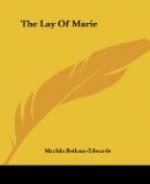Again, if we compare the fables which generally pass for Aesop’s, with those written by Mary, we shall perceive that the translation of the latter could never have been regarded as a literal version of the former. She is a great deal more particular than Aesop; her moralizations are not the same. In a word, I think she comes nearer to Phaedrus than to the Greek writer.
It will, no doubt be answered, that the Works of Phaedrus have only been known since the end of the 16th century. This I admit; but am not the less persuaded that Mary was better acquainted with Phaedrus than with Aesop. It will, moreover, be contended, that she has herself declared, that the English version, which served her as a model, was a translation from the Greek. To this I reply; first, that Phaedrus’s fables may very properly be stiled Aesopian, as he has himself called them:
Aesopus auctor quam materiam
reperit,
Hanc ego polivi versibus senariis.[21]
And, secondly, that although Mary possessed the fire, the imagination, and the genius of a poet, she nevertheless had not the criticism, or erudition, of a man of letters. For example; she informs us, that before her fables were translated into English, they had already been turned from Greek into Latin by Aesop.[22] She then gives the fable of an ox that assisted at mass, of a wolf that keeps Lent, of a monk disputing with a peasant, &c.
Amongst these compilers of fables, we find the names of Romulus, Accius, Bernardus, Talon, and many others anonymous. The first is the most celebrated; he has addressed his fables to his son Tiberius; they are written in Latin prose, sixty in number, and many of them are founded upon those of Aesop and Phaedrus. Rimilius published them at the end of the 15th century, and Frederic Nilant gave an edition in 1709, at Leyden, with some curious and interesting notes. Fabricius, in his Bibliotheca Latina, says, that these sixty fables are more than five hundred years old.[23] I have already mentioned that there is a MS. of them in the Royal Library in the British Museum, 15 A. VII., which was written in the 13th century, and contains only fifty-six fables. They are said, in the preface, to have been translated out of Greek into Latin, by the Emperor Romulus. Mary likewise mentions this Romulus, and gives him the same title. After having remarked with how much advantage learned men might occupy themselves, in extracting from the works of the ancient philosophers, proverbs, fables, and the morals they contained, for the purpose of instructing men, and training them to virtuous actions, she adds, that the emperor had very successfully pursued the plan, in order to teach his son how to conduct himself with propriety through life[24].




